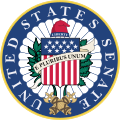
Many U.S. congressional committees (standing committees and select or special committees) operate in the United States Senate. Senators can be a member of more than one committee.

Many U.S. congressional committees (standing committees and select or special committees) operate in the United States Senate. Senators can be a member of more than one committee.
As of 2017 [update] , there are 88 subsidiary bodies of the US Senate: 16 standing committees with 67 subcommittees, four non-standing committees, and four joint committees. [1]
| This article is part of a series on the |
| United States Senate |
|---|
 |
| History of the United States Senate |
| Members |
| Politics and procedure |
| Places |
There are five non-standing, select, or special committees, which are treated similarly to standing committees. [17]
| Committee | Chair | Ranking Member | Ref. |
|---|---|---|---|
| Aging (Special) | Rick Scott (R-FL) | Kirsten Gillibrand (D-NY) | [2] [3] |
| Ethics (Select) | James Lankford (R-OK) | Chris Coons (D-DE) | [2] [3] |
| Indian Affairs (Permanent Select) | Lisa Murkowski (R-AK) | Brian Schatz (D-HI) | [2] [3] |
| Intelligence (Select) | Tom Cotton (R-AR) | Mark Warner (D-VA) | [2] [3] |
| International Narcotics Control (Permanent Caucus) | John Cornyn (R-TX) | Sheldon Whitehouse (D-RI) | |
Senate committees are divided, according to relative importance, into three categories: Class A, Class B, and Class C. In general, individual Senators are limited to service on two Class A committees and one Class B committee. Assignment to Class C committees is made without reference to a member's service on any other panels. [18]
Standing committees are permanent bodies with specific responsibilities spelled out in the Senate's rules. Twelve of the sixteen current standing committees are Class A panels: Agriculture; Appropriations; Armed Services; Banking, Housing and Urban Affairs; Commerce, Science, and Transportation; Energy and Natural Resources; Environment and Public Works; Finance; Foreign Relations; Governmental Affairs; Judiciary; and Health, Education, Labor and Pensions. [ citation needed ]
There are four Class B standing committees: Budget, Rules and Administration, Small Business, and Veterans' Affairs. There are currently no Class C standing committees.[ citation needed ]
Other (i.e., Indian Affairs), select and special committees are ranked as Class B or Class C committees. They are created for clearly specified purposes. There are currently two Class B committees: the Select Committee on Intelligence and the Special Committee on Aging, and two Class C committees: the Select Committee on Indian Affairs and the Select Committee on Ethics. [ citation needed ]
Joint Committees are used for purposes of legislative and administrative coordination. At present there are four: the Joint Economic Committee (Class B), the Joint Committee on the Library (Class C), the Joint Committee on Printing (Class C), and the Joint Committee on Taxation (Class C).[ citation needed ]
Standing committees in the Senate have their jurisdiction set by three primary sources: Senate Rules, ad hoc Senate Resolutions, and Senate Resolutions related to committee funding. To see an overview of the jurisdictions of standing committees in the Senate, see Standing Rules of the United States Senate, Rule XXV.
Each party determines their committees leads, who serve as chair in the majority and ranking member in the minority. The table below lists the tenure of when each member was selected for their current term as committee lead. The Republican party rules stipulate that their leads of standing committees may serve no more than three congressional terms (two years each) as chair or ranking member, unless the full party conference grants them a waiver to do so. [19] The current majority party is listed first for each committee.
IV.B. Standing Committee Chair/Ranking Member Term Limits (1) A Senator shall serve no more than six years, cumulatively, as chairman of the same standing committee. This limitation shall not preclude a Senator from serving for six years, cumulatively, as chairman of other committees, in series, if the Senator's seniority and election by committee members provides the opportunity for such additional service. (2) Service as ranking member shall also be limited to six years, cumulatively, in the same pattern as described in (1) above. Time served as ranking member shall not be counted as time served as chairman. Once a Senator has completed six years as chairman of a committee, there will be no further opportunity for that Senator to serve as ranking member of that same committee if control of the Senate shifts and Republicans go into the minority. The opportunity for service as ranking member, outlined in (2) above, takes place either before or in interruption of the Senator's six-year term as chairman, not after.